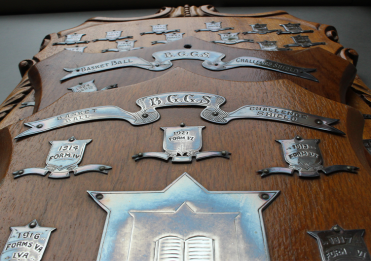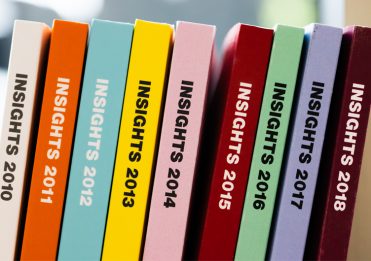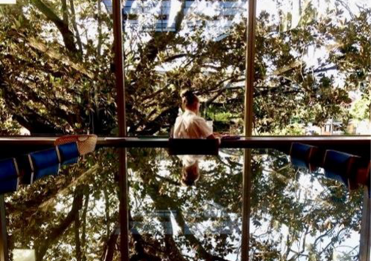The impact teachers have on their students is most often acknowledged in end-of-year gifts, but also—more importantly—in the personally written cards many teachers value and save. However, what if that teacher was also a Principal? Girls Grammar has had many exceptional Lady Principals and the influence they have had on the School and students is significant. There is one ‘object of substance’ that is proof of the substantial impact one Principal had on the girls in her care.
In the Annie Mackay Room in Main Building, there is an imposing Honour Board, much larger than all the others. Taking up most of one wall, the Mackinlay Honour Board takes pride of place, and, if keen observers look up to the entablature at the top, they will read the heartfelt dedication:
A memorial to Mary Mackinlay LLA erected by her pupils.
Such a memorial begs the observer to discover who Mary Mackinlay was. Who was this educator who left such an indelible impression that, after a short tenure as the Principal, an expensive memorial was commissioned by those she inspired?

The Mackinlay Honour Board pyramidal entablature with the dedication
Mary Mackinlay was born near Lockerbie, Scotland, circa 1841. She attended Cheltenham Ladies College as a ‘mature age’ student and in the school’s 1870 account book, a note has been made of payment by Miss Mackinlay for courses in music, drawing, physical geography, and Italian. Renowned principal, Dorothea Beale, gave her ‘high recommendations’ and introduced her to highly sought-after formal teacher training, aims, and methods. Miss Beale’s mentoring and Miss Mackinlay’s aptitude led to Miss Mackinlay teaching English at Cheltenham Ladies College until 1875 and then at Bath High School, where several of Miss Beale’s students were employed.
Miss Mackinlay then attended the University of St Andrews from 1877 to 1878, taking English Literature, French, Education, and Physiology. She was awarded a LLA Diploma (Lady Literate in Arts) which allowed Miss Mackinlay and other women to study by correspondence.
On 1 February 1878, a Girls Grammar Board Minute noted that the Chair, Mr Justice Charles Lilley, had written—via the Agent General in London—to the Lady Principal, Girton College, Cambridge, Marianne Bernard, asking of her to recommend a Lady Principal for Girls Grammar, with a salary of 300 pounds per annum. He stipulated the new principal should be ‘capable of teaching the higher work of the school, especially in Latin, Euclid, and Algebra, with French or German as additional subjects … have some experience of teaching, and she should not be too young—by this he meant not under 27’ (Theobald, 1996, p. 102).
Miss Mackinlay met all these requirements with her LLA, and Marianne Bernard spoke highly of her ‘attainments and powers of teaching’ (The Queenslander, 1878). She was also 37 years old at the time of her appointment, and as the reporter in The Queenslander noted, ‘Miss Mackinlay has a kind and genial manner which is calculated to win and retain the confidence of her new pupils’.
Miss Mackinlay arrived in Brisbane in October 1878 on the incoming Torres Strait mail steamer and was to lead the School most astutely, making vast improvements during the three years she was in charge. ‘The school had prospered during her leadership. She found it with some 40 pupils on the roll; she left it with 80. She found it in debt; she left it out of debt and with every prospect of its henceforth paying its own way and standing upon its own merits’ (The Week, Saturday 24 December 1881 p.8). She also inaugurated a boarding system by establishing a residence for the pupils on Petrie Terrace, and in 1881, there were 18 boarders (The Week 1904, ‘Memorial to Miss Mackinlay’).

1914 The original board with eight panels in the Annie Mackay room
Miss Mackinlay’s ‘kind and genial’ manner coupled with her able leadership of the School had thus led to a doubling of student numbers and the establishment of its finances on a stable footing. It was most likely her transformation of this experimental branch of Brisbane Grammar School that inspired the Board of Trustees to create a separate and independent school for girls the year after she left. She must have taken great pleasure in returning to the School in March 1884 as a member of the official party to witness the opening of the fine new building of an independent school for girls on Gregory Terrace.
Miss Mackinlay retired from Girls Grammar at the end of 1881 to marry a widower, Mr James Robert Dickson on 5 January 1882, at St Paul’s, Carcoar, New South Wales. Mr Dickson was a successful business owner and politician, and amongst his political appointments were those of Colonial Treasurer, Premier of Queensland, and in 1900 he was elected as Australia’s first Minister of Defence. The following year, Mr Dickson received a knighthood, making Miss Mackinlay, Lady Dickson.

James Robert Dickson with his first wife, Annie Ely, and family, Toorak House, Hamilton, ca. 1872 StateLibQld 1 89640
Sadly, this marriage was far from conventional. Dickson’s 13 children appear to have been less than pleased with his choice of spouse. The daughters—Alice, Edith, Ada, Agnes, Annie, Lucy, and Grace—attended Girls Grammar, with Annie, Alice, Agnes, and Ada being pupils during Lady Dickson’s tenure as Lady Principal.
Lady Dickson, now a married woman, was expected to give up her employment. For the next 20 years in his governmental roles, Mr Dickson travelled widely, but there is no evidence that Lady Dickson accompanied him on any of these trips or his official engagements—although there are quite a number of newspaper reports that his daughters accompanied him on such occasions.
Mr Dickson had been a regular visitor to Toowoomba and the Darling Downs region in the early part of his marriage to Lady Dickson, and she must have been familiar with the town, having accompanied him on visits there. When the house, Braemar on Long Street, became available to rent in 1887, Lady Dickson took the opportunity to move in and establish her independence. She created a preparatory school for boys and, in 1888, purchased Jeanfield, and ran the school from this premises from 1889.
Sadly, Lady Dickson died alone and infirm in 1902. She suffered an illness which had caused the local Magistrate, Colonel Richard Moore, such concern that the week before she passed away, he mentioned her condition to the Home Secretary, Mr Foxton, with the suggestion she might have to be admitted to the Asylum. On her death, Colonel Moore, whose duty it was to organise the funeral, wrote a scathing letter to the Under Secretary for the Home Department, WH Ryder. In the letter, the breakdown of her marriage was apparent, along with the fact she did not appear to have the rights, as Mr Dickson’s widow, to live at Toorak, Hamilton. Colonel Moore described her final, lonely weeks—when no one close to Lady Dickson had come forward to care for her: ‘She has been living a life for some time past that virtually she has no friends here … and no family of her own in Australia’ and that, despite being the late Premier’s wife, “was allowed to die like a dog”‘ (Magistrate Richard Moore’s letter to WH Ryder re: Lady Mary Dickson’s final days, death, burial and will, written 23.2.1902, held in Fryer Library F447.MJK).

1902 Colonel Moore’s letter pages 1 and 2

1902 Colonel Moore’s letter pages 3 and 4
She was buried in the Anglican section of Toowoomba and Drayton Cemetery. Her headstone, surmounted by a plain cross, bears the simple inscription:
In Memory of Mary Dickson
Widow of the late Sir James Dickson
Who died at Toowoomba
February 22, 1902, Aged 60 years

Mary Dickson’s grave—Drayton and Toowoomba Cemetery
In June 1902, at a request from the Drayton and Toowoomba Cemetery, the Girls Grammar Board agreed to cover the cost of a tombstone and railings to protect the grave, as not one family member or friend had come forward to do so. More recently, in 2005, the School paid for the headstone and grave to be restored and cleaned—a small but fitting tribute to one of Girls Grammar’s respected and obviously loved past Lady Principals.
Lady Dickson’s love of Girls Grammar and its students is also obvious in her final act. In Lady Dickson’s will, much of her estate, which comprised several properties in Toowoomba, including her home, Jeanfield, along with capital held in various deposit accounts, was to be paid to the Trustees of Brisbane Girls Grammar School for the foundation of a scholarship to assist and pay for a past student to attend university. It was for £50 a year for each three years of study and was to be awarded to a student proceeding to university. This award could not be held concurrently with any other scholarship. The Mackinlay Scholarship was awarded for the first time in 1906 to Elsie Pascoe, who left for Sydney University to study medicine the following year.

1904 Fifth Form with Mrs Jessie Dakin—Elsie Pascoe seated 2nd on the right.
Once qualified, Elsie went on to work in the NSW Public Mental Health System as the following newspaper article reports:

1927 20 August Smiths Weekly NSW p13
In 1904, two years after her death, students who attended the School during Lady Dickson’s principalship collected funds for a memorial board in her honour. Led by Eva McLay (Hockings, 1882), the Old Girls Committee raised funds for the board to be erected in what was the Assembly Hall, now known as the Annie Mackay Room. The money was presented to the School to commemorate what Head Mistress, Miss Milisent Wilkinson, described as the ‘splendid work she did for the School’ (Wilkinson, 1904). The Honour Board was unveiled in 1904 by the Acting Governor, Sir Hugh Nelson, and attended by numerous dignitaries. It is interesting to speculate why an Acting Governor and dignitaries were present at the unveiling of an honour board with no mention of any family.
Mr Reginald Roe, who had been Headmaster of Brisbane Grammar School, and had worked for several years with Lady Dickson, supported such a memorial. He spoke of her wholehearted devotion to the School and that she had allocated most of her own funds for the advancement of the School (The Brisbane Courier, 1904). He also stressed how important he felt it was to have permanent records of the students who gained honour through their scholastic achievements (The Week, 1904).
Miss Eva Hockings arranged for the architect, Robin Dods, to provide plans for the Board, which he generously completed free of charge. The original Honour Board was made of dark, unvarnished pine, divided into four panels, surrounded by mouldings, and surmounted by a ‘pyramidal entablature’, with the frieze bearing the dedication. The four panels were headed Fairfax Prize, Medals, Extra Honour and Mackinlay Scholarships, and the names of pupils who had gained these awards between 1878 and 1904 were included.
In 1987, the Old Girls Association refurbished the original board. The list of names on the original board was rationalised, gold leaf printing replaced the ‘chocolate coloured’ paint, and six more panels were added.

The plaque identifying the OGA restoration
These are now labelled:
- Queensland University Medals
- Fairfax Prizes
- Senior and Junior Medals
- Extra Honours and Teaching Scholarships
- Other Awards
- Queensland University Scholarships (two panels)
- Honours: Churchill Fellowships; Fellow of the Royal Society; and Rhodes Scholars
- Mackinlay Scholarships (two panels)

The plaque identifying the OGA restoration
Lady Dickson was a strong, independent woman who believed in the importance of women’s education. Her personal battle to be educated as a mature-aged student, to journey across the world to realise her ambitions, and to strengthen ‘an experiment’ to the point it became viable, points to an inspired and inspiring educator. The Mackinlay Honour Board is a lasting and fitting tribute to a woman who gave honourable and diligent service to furthering the education of the young women of Girls Grammar, who deserved—as the writer of the article in The Week on 24 December 1881 suggested—to ‘look back with pleasure and pride in her leadership of the School’.
Mrs Jenny Davis
Sesquicentenary Research Officer
References
Brisbane Girls Grammar School Annual Report Milisent Wilkinson, 1904
BGGS Board Minutes ‘Re: Lady Dickson deceased’, 27th June 1902
Magistrate Richard Moore’s letter to W H Ryder re Lady Mary Dickson’s final days, death, burial and Will, written 23.2.1902, held in Fryer Library F447.MJK
McNab, R. Letter to Trustees, dated 13 June 1902. Re Lady Dickson’s tombstone.
Mulligan, Barbara, 2022. (Married to great grandson of Ada Dickson) CYRUS JOHN RICHARD WILLIAMS 1862-1942; Second marriage, https://cyrusjohnrichardwilliams.weebly.com/the-second-marriage.html#_edn1
Orr, Francesca (Email), (RHS) Staff f.orr@rhsb.gdst.net, Alumnae and Community Liaison Officer Royal High School, Bath. 15/08/23
Smiths Weekly NSW, 1927 20 August p. 13, Women doctors’ choice.
Theobald, Marjorie R. Knowing Women: Origins of Women’s Education in Nineteenth-Century Australia, Cambridge University Press, 1996
The Week, Saturday 24 December 1881 p.8, ‘Breaking Up’.
The Week 16 December 1904 p. 27, ‘Memorial to Miss Mackinlay’.
The Queenslander 19 October 1878, p. 69, ‘Current News: By telegraph and otherwise’.
The Telegraph, Saturday 10 December 1904, p 13
The Brisbane Courier, 10 December 1904 p. 7, ‘Woman’s World: Brisbane Girls’ Grammar School’.
Worker, Saturday 12 January 1901, p 8, ‘In a Woman’s Mind by Aunt Martha’.





